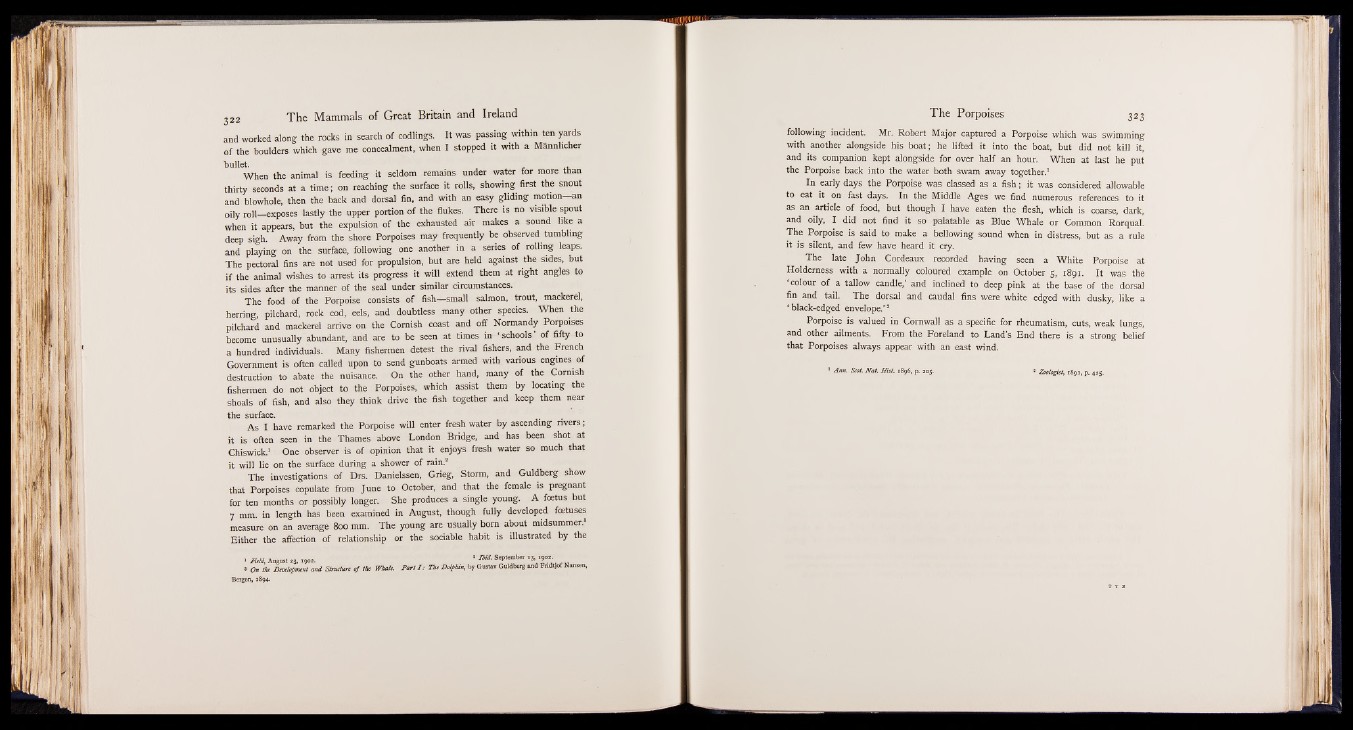
and worked along the rocks in search of codlings. It was passing within ten yards
of the boulders which gave me concealment, when I stopped it with a Männlicher
m m
When the animal is feeding it seldom remains under water for more than
thirty seconds at a time; on reaching the surface it rolls, showing first the snout
and blowhole, then the back and dorsal fin, and with an easy gliding motion— an
oily roll— exposes lastly the upper portion of the flukes. There is no visible spout
when it appears, but the expulsion of the exhausted air makes a sound like a
deep sigh. Away from the shore Porpoises may frequently be observed tumbling
and playing on the surface, following one another in a series of rolling leaps.
The pectoral fins are not used for propulsion, but are held against the sides, but
if the animal wishes to arrest its progress it will extend them at right angles to
its sides after the manner of the seal under similar circumstances.
The food of the Porpoise consists of fish— small salmon, trout, mackerel,
herring, pilchard, rock cod, eels, and doubtless many other species. When the
pilchard and mackerel arrive on the Cornish coast and off Normandy Porpoises
become unusually abundant, and are to be seen at times in «schools' of fifty to
a hundred individuals. Many fishermen detest the rival fishers, and the French
Government is often called upon to send gunboats armed with various engines of
destruction to abate the nuisance. On the other hand, many of the Cornish
fishermen do not object to the Porpoises, which assist them by locating the
«final« of fish, and also they think drive the fish together and keep them near
the surface.
As I have remarked the Porpoise will enter freshwater by ascending rivers;
it is often seen in the Thames above London Bridge, and has been shot at
Chiswick.1 One observer is of opinion that it enjoys fresh water so much that
it will lie on the surface during a shower of rain.2
The investigations of Drs. Danielssen, Grieg, Storm, and Guldberg show
that Porpoises copulate from June to October, and that the female is pregnant
for ten months or possibly longer. She produces a single young. A foetus but
7 mm. in length has been examined in August, though fully developed foetuses
measure on an average 800 mm. The young are usually born about midsummer.8
Either the affection of relationship or the sociable habit is illustrated by the
1 Field, August 23, 1902. * 9 SePtember I3. I9°2' » On the Development and Structure o f the Whale. P a rt I : The Dolphin, by Gustav Guldberg and Fridtjof Nansen,
Bergen, 1894.
following incident. Mr. Robert Major captured a Porpoise which was swimming
with another alongside his boat; he lifted it into the boat, but did not kill it,
and its companion kept alongside for over half an hour. When at last he put
the Porpoise back into the water both swam away together.1
In early days the Porpoise was classed as a fish; it was considered allowable
to eat it on fast days. In the Middle Ages we find numerous references to it
as an article of food, but though I have eaten the flesh, which coarse, dark,
and oily, I did not find it so palatable as Blue Whale or Common Rorqual.
The Porpoise is said to make a bellowing sound when in distress, but as a rule
it is silent, and few have heard it cry.
The late John Cordeaux recorded having seen a White Porpoise at
Holderness with a normally coloured example on October 5, 1891. It was the
‘ colour of a tallow candle,’ and inclined to deep pink at the base of the dorsal
fin and tail. The dorsal and caudal fins were white edged with dusky, like a
‘ black-edged envelope.’ 2
Porpoise is valued in Cornwall as a specific for rheumatism, cuts, weak lungs,
and other ailments. From the Foreland to Land’s End there is a strong belief
that Porpoises always appear with an east wind.
Ann. Scot. Nat. H ist. 1896, p. 205. 9 Zoologist, 1891, p. 425.